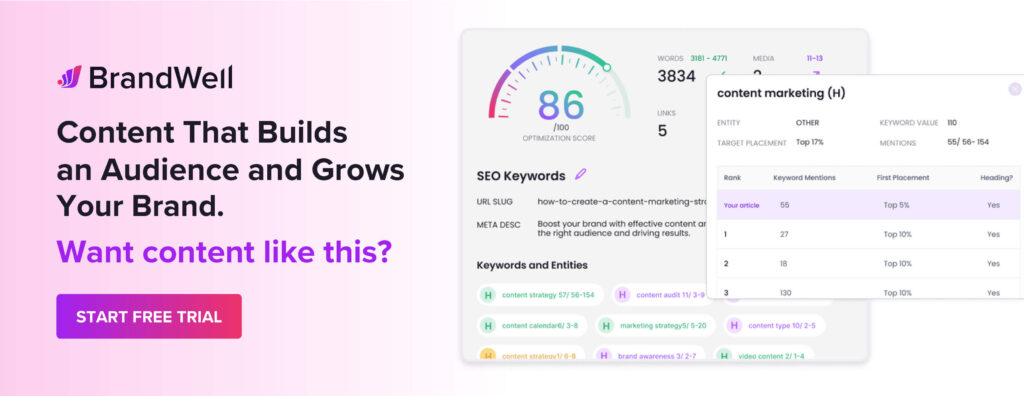Discover top guides, trends, tips and expertise from AIO Writers
What Does It Mean to Scale Content? A Comprehensive Guide
Julia McCoy
Friday, 12th May 2023
Has your blog traffic plateaued? Perhaps with the flatlining traffic growth or because of it, you are also losing ground to the competition on Google.
How can you remedy this?
At the risk of answering a question with another question, are you publishing enough quality content? If the answer is no, the solution is to publish more content – much more of it if you are going to improve your visibility on Google and position yourself as an authority in your niche.
In this post, you will learn:
- The meaning of content scaling.
- How scaling content can benefit your business.
- Some agencies using automation tools have reported significant increases in content volume while maintaining quality.
Let’s get started.
What is Content Scaling?
Content scaling is the process of increasing the quantity and reach of your content in a way that makes efficient use of available resources. It involves creating more content, publishing it on multiple channels, and using proven SEO tactics to target it to the right audiences. It can also mean expanding existing content to target more searches.
When done right, content scaling helps to increase engagement with your brand. It boosts organic traffic to your website by giving search engines like Google more content to index.
To effectively scale content creation, you need to focus on producing quality content that is optimized around topics that your target audiences are searching for online.
Simply publishing more content isn’t going to cut it – the new content must be in-depth and offer unique perspectives that expand on existing knowledge.
Your content scaling effort must follow a deliberate strategy that goes beyond simply publishing content in bulk. It must have the overall goal of establishing a search presence throughout the customer journey. So keyword research is a critical component of any content scaling strategy.
How Scaling Content Creation Can Help Your Business
Content creation is a central part of any successful SEO plan. Good technical SEO, backlinks, and all the other things you do to position a website for success on search engines count for nothing without content. A modern website is ultimately judged on both the quality and quantity of its content.
A school of thought some publishers promoted for a while is that content quality trumps content velocity. For that to be true the quality of the bulk content has to be really poor – thin 300-word articles that do not target any keyword and which do not provide any value for the reader.
Where the content quality is decent, publishing 10 well-researched 1,500-word articles will always be better than publishing one 10,000-word pillar post per month.
Yes, traffic may take off like a rocket in the early days when you focus on quality, but after a while, growth will stall. You simply can’t grow sustainable blog traffic by publishing 12 posts a year. And just to add, increasing the publishing frequency does not mean you have to sacrifice content quality.
Here are more reasons why it pays to scale up your content production:
1. Improve Your Visibility Online
The more quality content you produce, the better chance you have of ranking for more searches in Google and getting noticed by more potential customers.
But without a clear strategy and process, you can easily end up creating new content on keywords you have covered already with previous articles. This will not improve your visibility online as the new content will not be targeting any new searches. Instead, it can lead to content fatigue.
To scale up blog posting frequency without risking reader burnout, make sure each article offers something unique that provides real value for its intended audience
2. Establish Authority
Publishing quality blog posts helps establish trust between your business and your target audience while helping position you as an expert in your field. When you publish more of such content, it will boost your authority and position your brand even higher in the eyes of your peers and customers alike.
3. Generate More Leads for Your Business
Creating helpful articles related to products or services your company offers widens your content’s reach and draws the attention of more qualified leads. Lead generation is a game of numbers: more, higher quality leads entering your sales pipeline means more potential customers and sales for your business.
Scaling up content creation isn’t just about pumping out more content. It requires careful planning and strategic execution if it is going to drive results for your business.
Key Takeaway: To scale content creation effectively, it’s important to set clear goals and objectives, research your audience thoroughly, create an editorial calendar for planning out production cycles in advance, and automate where possible using available tools and software solutions.
6 Types of Content You Can Scale
You can scale several types of content, meaning you can produce them in large quantities without compromising on quality. Here are some examples:
Listicles
Listicles are articles presented in a list format, often featuring numbered or bullet points. They’re popular because they provide easily digestible information for readers who may have limited time or attention spans.
Listicles can cover any topic but should always offer valuable insights to keep readers engaged.
Here’s an example of a listicle from one of our BrandWell blogs:
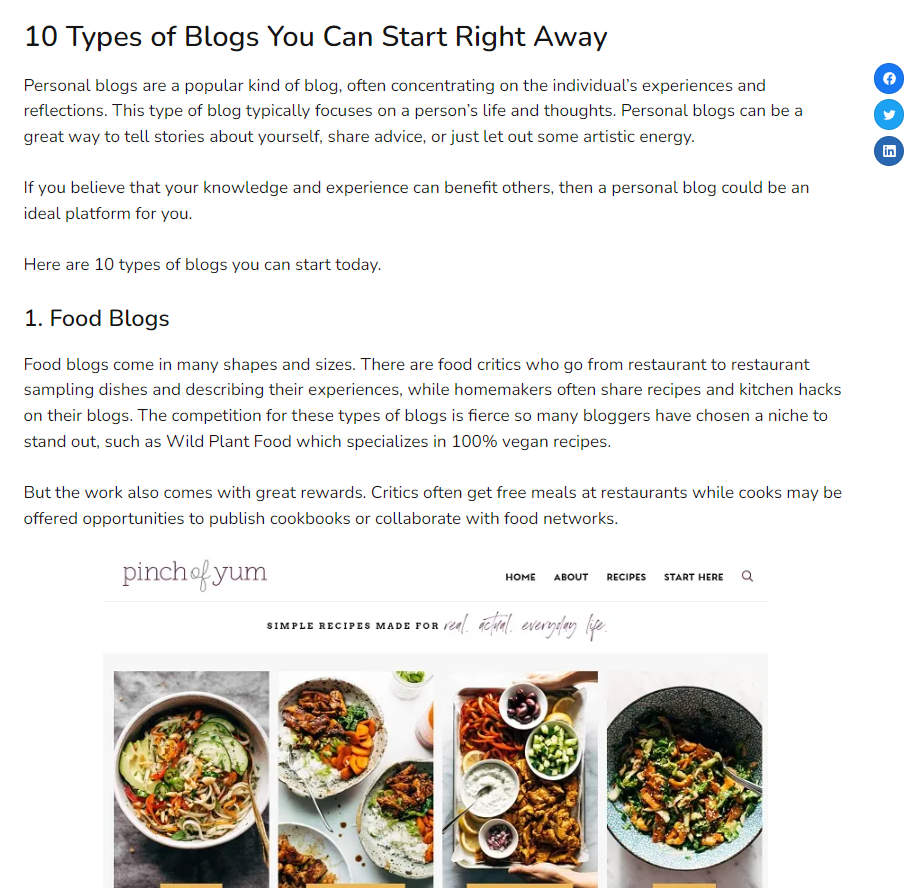
In this example, the content is presented in the form of a numbered list of types of blogs, with each item providing a brief explanation and examples. This format is a common type of listicle used to convey information in an easy-to-digest and engaging way.
How-to Guides
How-to guides teach readers how to accomplish specific tasks or solve problems step-by-step. These pieces of content demonstrate expertise on a subject matter while providing actionable advice that helps users achieve desired results.
Well-written how-to guides not only educate but also build trust between your brand and your audience.
Here’s an example of a how-to guide from the BrandWell blog:
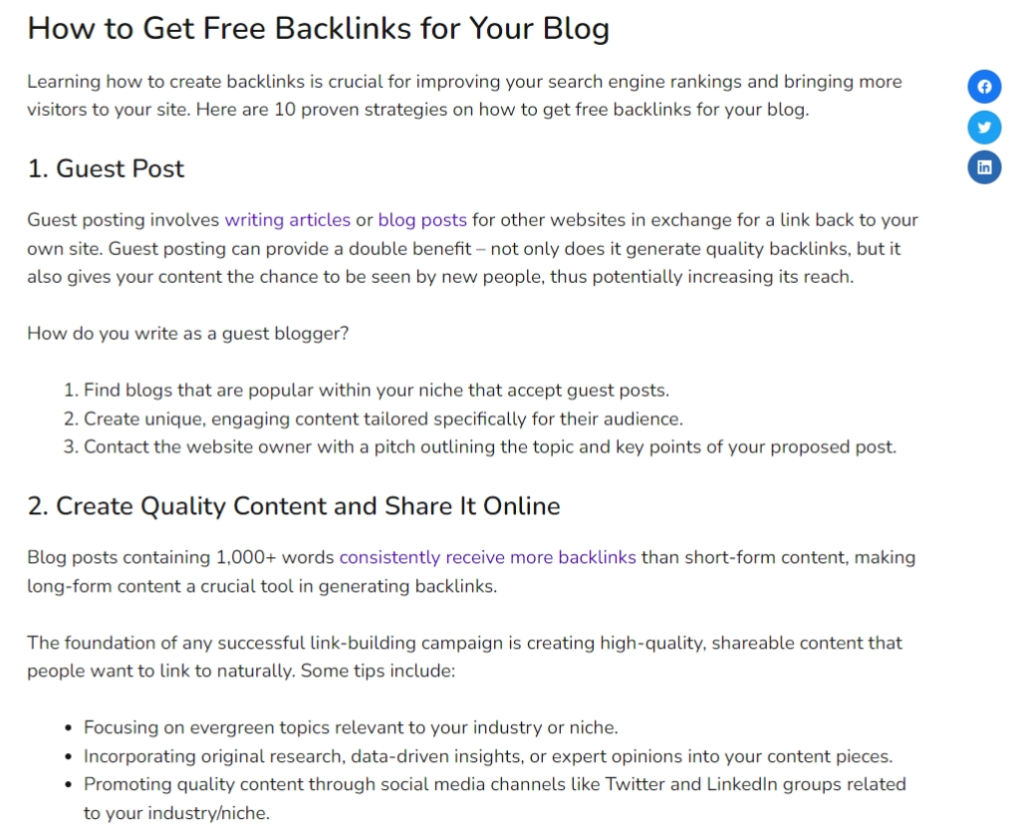
In this example, the content is presented as a step-by-step guide to getting free backlinks for your blog. This format is a common type of content used to teach readers how to perform a specific task or complete a project.
Educational Articles
Educational articles aim to inform readers about particular topics by presenting well-researched facts, data, and expert opinions. These articles showcase thought leadership within an industry while helping audiences expand their knowledge base.
Here’s an example of an educational article from the BrandWell blog:
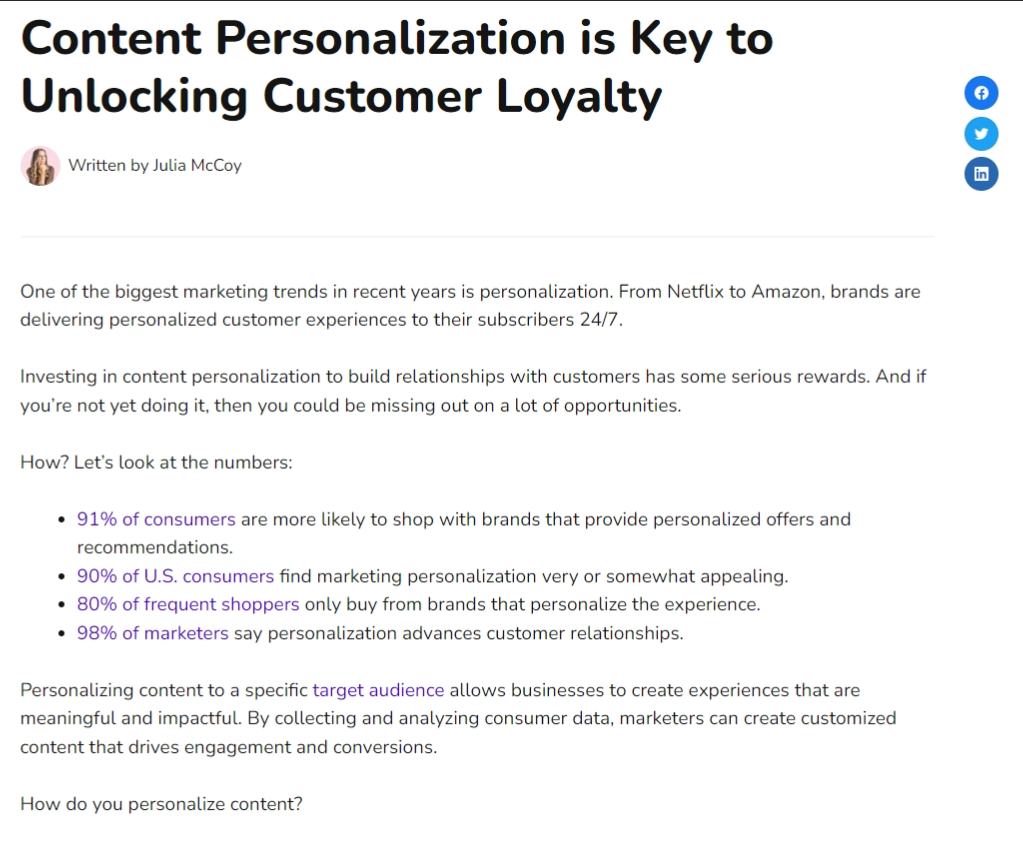
Videos
Videos are a powerful medium for storytelling and engagement, offering visual and auditory stimulation that can hold viewers’ attention longer than text-based content. Videos can be used to demonstrate products or services, share customer testimonials, or provide educational material in an easily digestible format.
In this video, we put a human content writer to the test against BrandWell to show how AI is becoming just as good, if not better, than humans — serving as a wake-up call for writers to continuously improve their craft.
Infographics
Infographics use visuals to represent data, statistics, or complex information in a simplified manner. They’re particularly effective at breaking down complicated concepts into easy-to-understand graphics that help readers retain the information more effectively.
Here’s an example of an infographic that makes data easier to digest than writing it in text form:
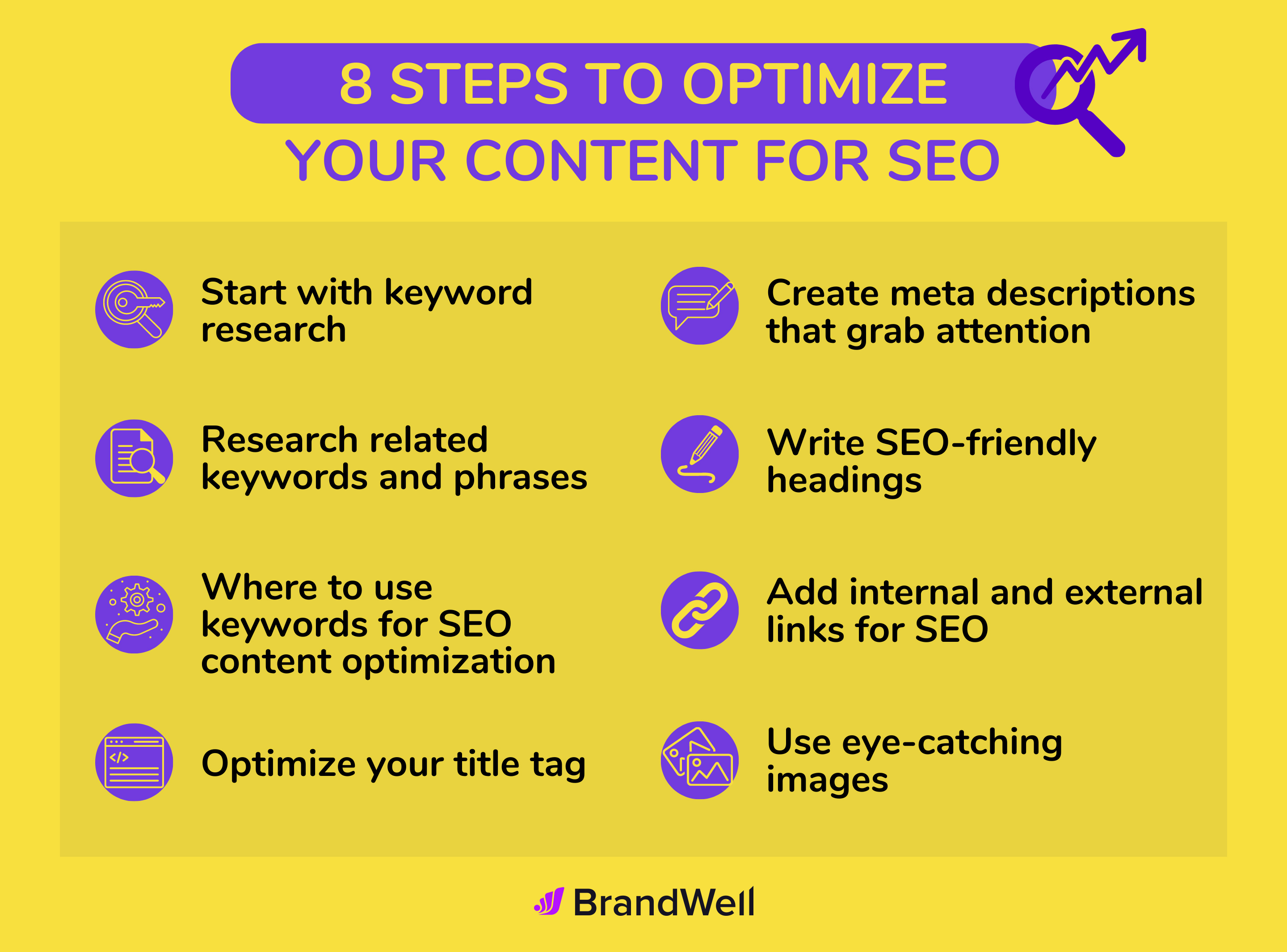
Podcasts
Podcasts offer audio-based content that allows listeners to consume information while multitasking – whether they’re commuting to work or doing household chores. Podcasts cater to various interests and niches, making them an excellent way for brands to connect with target audiences through engaging conversations and interviews.
Good examples of podcasts include the Search Engine Journal Show, the Digital Marketer Podcast, and Beyond the Story.
Incorporating these six types of content into your content creation strategy will ensure you reach a diverse audience with different preferences for consuming information. By providing valuable insights across multiple formats, you’ll establish your brand as an authoritative source within your industry while driving traffic and conversions through effective SEO tactics.
How to Scale Content Creation, Step by Step
Scaling content creation can be challenging if you don’t have the right process and tools in place. Here are the steps to follow when scaling content production so that you get all of its benefits:
1. Establish Goals and Objectives
Before you start the content scaling effort, ask yourself why you are doing it. What do you want to achieve with the increased blog output?
Do you want:
- More website visits?
- Higher conversion rates?
- A larger social media following?
The answers to these questions are your goals and objectives. Refine them to make sure they are clear, targeted, and are what your business needs at this point. A few objectives of a content scaling strategy could be to:
- Increase page views.
- Boost customer engagement.
- Generate more leads.
With a clear vision of what the new content must accomplish, constructing an effective strategy to achieve it will become more straightforward.
2. Research Your Audience
Every piece of content must have a target audience in mind. You need to understand the target audience’s interests, preferences, needs, and pain points so that you can tailor each piece accordingly. If you are selling something, it’s crucial to cluster your topics/keywords according to where readers are on the sales cycle.
Conducting market research such as surveys or interviews with customers can give invaluable insights into what kind of topics they’d like to read up on. You can also turn to sites like Reddit and Quora to find questions your target readers are asking about your blog topics.
Another way to know the sub-topics your target readers are researching is to look up People Also Ask questions when you google your target keywords.
Google may surface PAA questions that are not relevant to your topic, but a good number will be. Adding those to your blog posts makes them more comprehensive and optimizes your content for more searches, which widens your traffic sources.
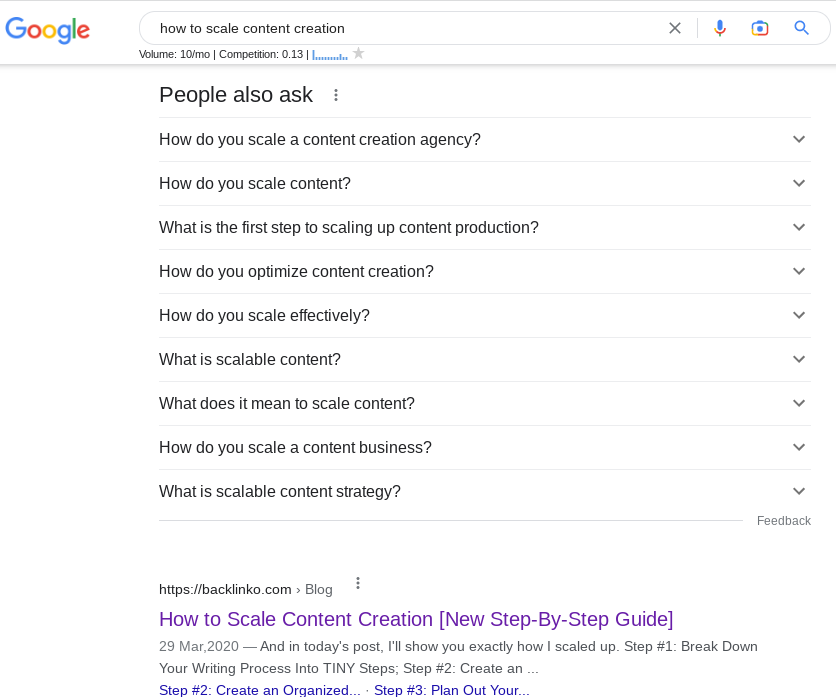
You can find what people are looking for by searching your keyword on Google
After researching your target audience, you should be able to answer questions on:
- What their main points are.
- The questions they typically ask.
- Where they live, and what they do for work.
All these are new angles you can take with your new content. They are potential ways new readers might discover your content. With all that information, you should have plenty of topics to cover with your blog content for the foreseeable future. These topics should ideally be organized according to your goals with them.
3. Break Down Your Process into Manageable Steps
Breaking down your writing process into smaller steps can help you manage your writing tasks more effectively and make the overall process less overwhelming.
Here’s a suggested breakdown of the writing process into smaller, manageable steps:
Keyword Research
- Identify the main topic or subject of your writing piece.
- Conduct keyword research using tools like Google Keyword Planner or other SEO resources.
- Identify relevant keywords and phrases that align with your topic and target audience.
Choose a Content Format
- Consider the purpose of your writing (informative, persuasive, instructional, etc.).
- Determine the most suitable content format, such as a blog post, article, report, or presentation.
- Take into account the preferences of your target audience and the platform you’ll be publishing on.
Outlining
- Create a clear and logical structure for your content.
- Start with an introduction that captures the reader’s attention.
- Organize your main points or arguments and supporting details into sections or paragraphs.
- Include transitions to ensure a smooth flow between ideas.
Editing
- Review your content for clarity, coherence, and effectiveness.
- Check sentence structure, grammar, punctuation, and spelling.
- Improve readability by eliminating unnecessary jargon or complex language.
- Ensure your content follows the appropriate tone and style guidelines.
Visuals
- Determine what type of visuals can enhance your content (images, graphs, charts).
- Select relevant visuals that complement your writing and aid in understanding.
- Ensure the visuals are high-quality, appropriately cited, and aligned with your content’s purpose.
Quality Checks
- Review the overall quality of your writing piece.
- Assess if the content meets the intended goals and objectives.
- Evaluate if the information provided is accurate, credible, and well-supported.
- Consider the coherence and consistency of your ideas throughout the piece.
Final Proofreading
- Conduct a final proofread to catch any remaining errors or typos.
- Pay attention to grammar, spelling, punctuation, and formatting.
- Read your content aloud to identify awkward phrasing or readability issues.
- Verify that all visual elements are correctly placed and labeled.
If you’re using BrandWell, the app will automate most of these steps for you, particularly the research, outlining, and writing parts which are the most time-consuming. All you have to do is enter your target keyword and wait a few minutes to edit the first draft generated by AI.
But before you go full steam writing your content, you will want to make sure you:
4. Create an Editorial Calendar
An editorial calendar is a visual workflow that guides your content team’s efforts. It shows a daily, weekly, or monthly publishing schedule, complete with which author is assigned to what post and what keyword each post must target.
An editorial or content calendar helps keep track of all upcoming projects and ensures nothing falls through the cracks. Coordinating the roles of writers, editors, and designers with deadlines and tasks will ensure that all involved remain in sync throughout the project.
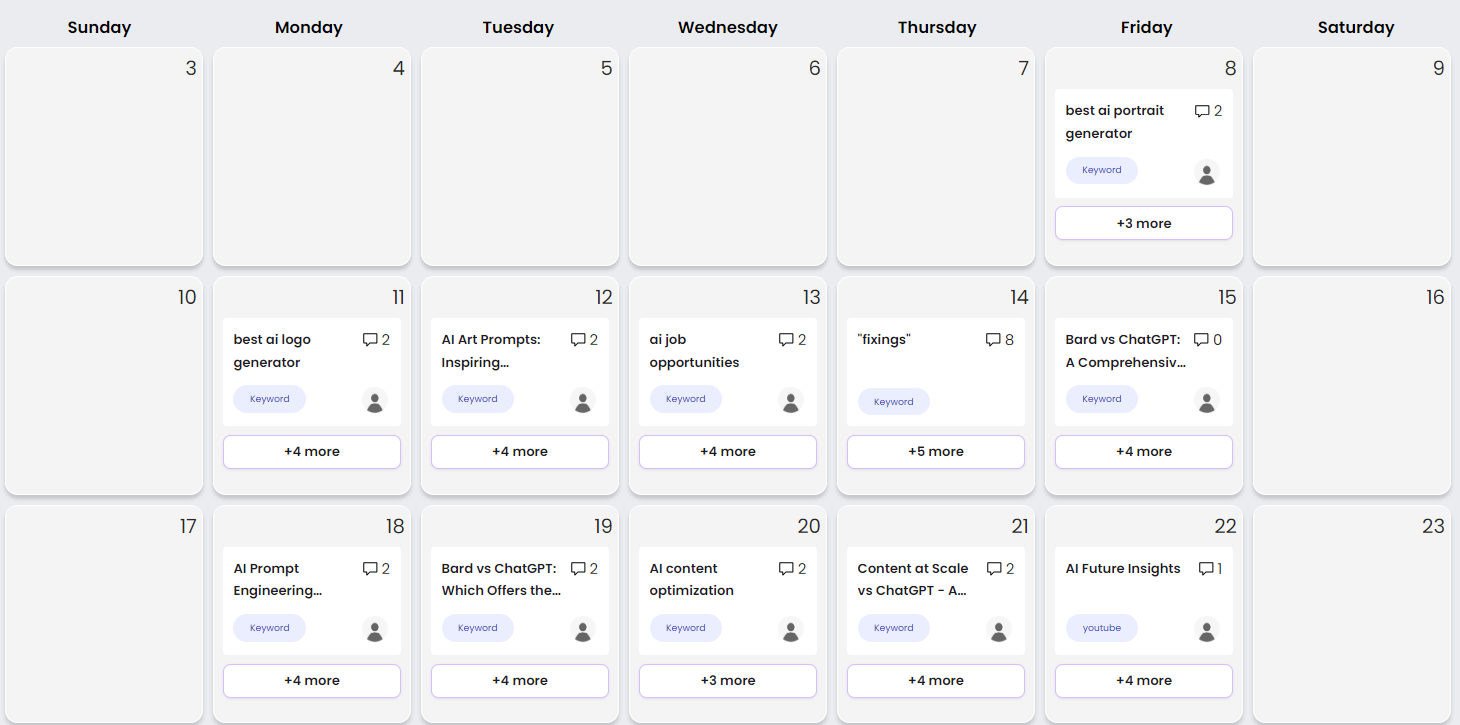
An editorial calendar in BrandWell
It is a mistake to start any content scaling project with no editorial calendar in place. Without one, it is impossible to stay organized. Instead of having your content calendar live in your head, write it down where your whole team can access it. Digital tools you can use to plan your content calendar include:
- Airtable
- Trello
- Evernote
- Google Drive
Scheduling out specific dates for different stages of production will also help streamline your workflow even further once everything gets rolling.
You can have different processes and platforms for scheduling and assigning posts to writers. For example, you can use Notion to assign new posts to writers. That means you can block out a whole week’s or month’s worth of posts and assign them to different writers with detailed briefs and a submission deadline.
With each completed post, the writer updates the calendar with the post’s title and link to the draft in WordPress (or the BrandWell app if you are using our tool). That alerts the graphic designer that the post now needs a featured image. It also officially enters the new post in the publishing pipeline.
After the graphic designer has uploaded the featured image to the content calendar, the editor knows the post is ready to be polished up for publishing. After they have uploaded the new post to WordPress and published it, the editor must go back to the content calendar and update it with the post’s publishing date and live URL.
So by merely looking at the content calendar, everyone on the team can see the status of each post, which before it is assigned to a writer will only show the target keyword.
5. Automate Where Possible
The biggest challenge for content teams looking to ramp up content production is the enormous cost and time investment it takes to do it manually. It often leads to burnout and a drop in the quality of the content.
Thankfully, there are several parts of the content production process that can be automated. BrandWell is one option for automating large parts of your growth marketing strategy
From keyword research to blog post creation and publishing, BrandWell saves you several hours and reduces the cost of content production to less than a penny per word.
In fact, Journey Engine, a marketing agency we recently signed up to BrandWell will be able to 25X increase the volume of content they are producing while spending slightly less than they were spending with a human writer.
BrandWell takes the pain out of outlining blog posts by automatically generating a brief for you. All the tool needs are the keyword you want the article to rank for in search engines and a few words of additional context.
The app also has a special feature for customizing the draft outline if there are sub-topics you feel must also be included. After customizing the outline, you can prompt the AI to generate the post, which will be ready to edit and optimize in about 4 minutes.
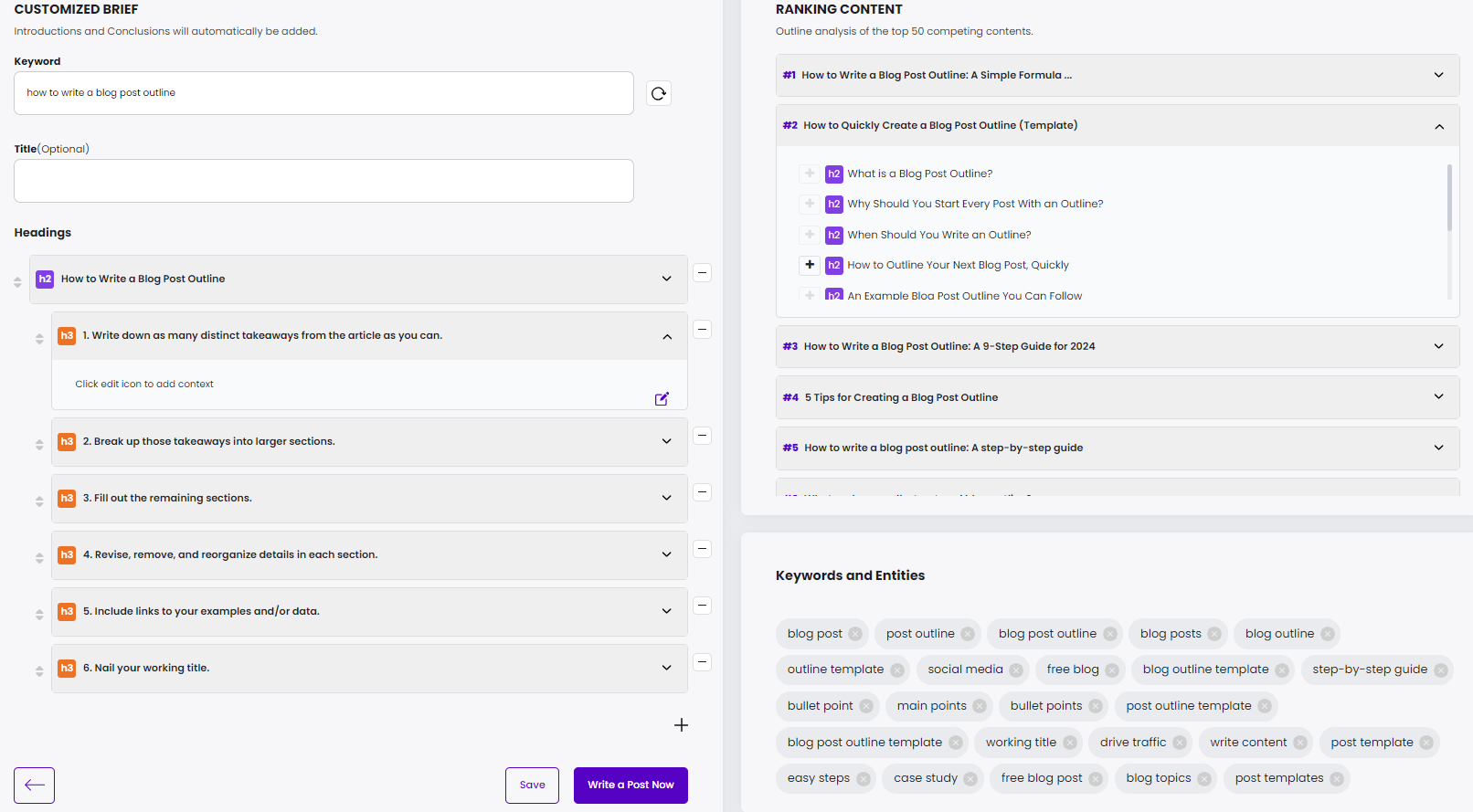
The draft the tool generates is optimized around your target keyword and related terms. Not just that, the draft is pre-formatted, complete with a table of contents, key takeaway boxes, and click-to-tweet links.
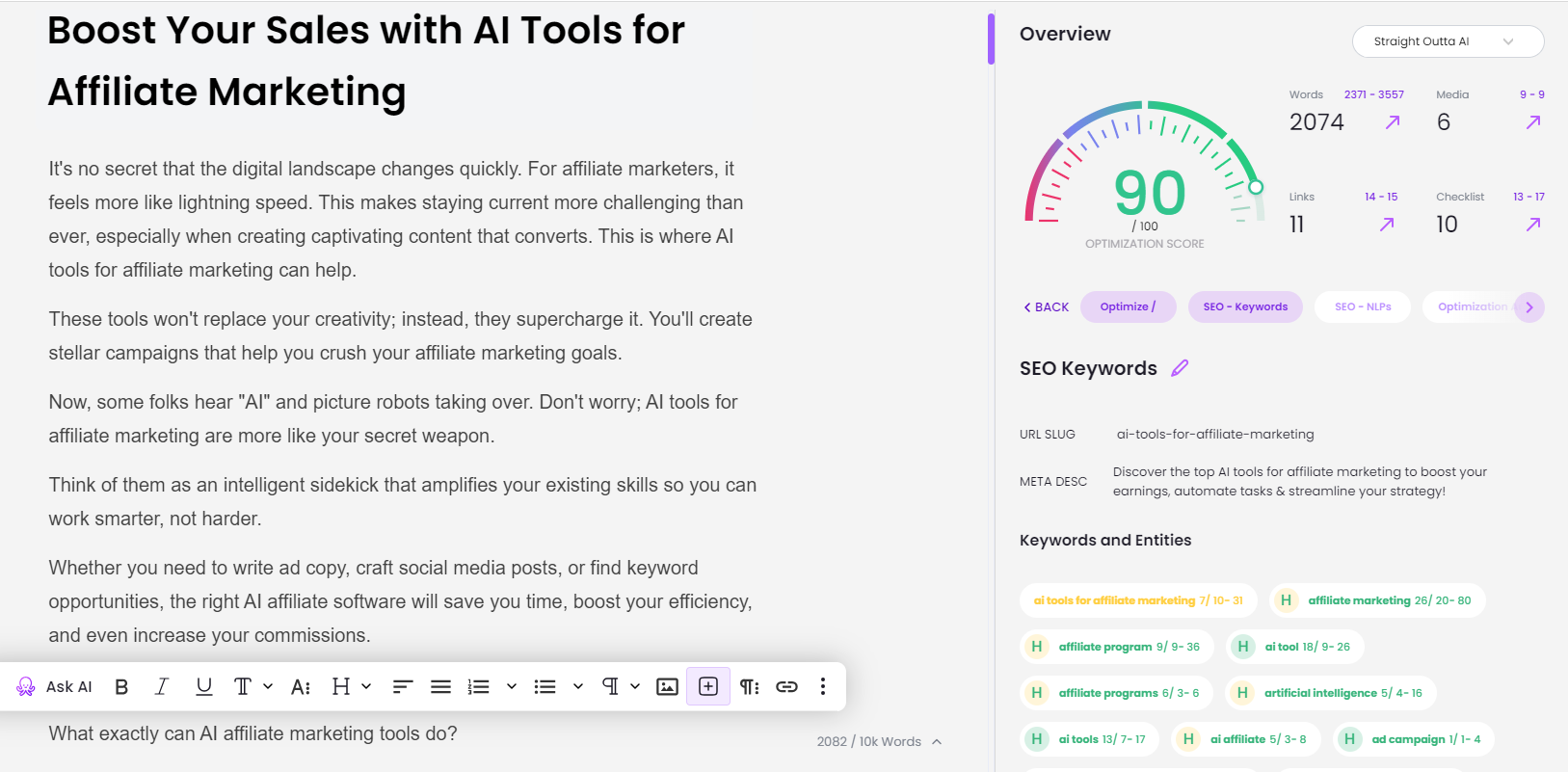
The AI even generates the SEO title and meta description and, if you connect our WordPress plugin, you can publish straight to your WordPress site without leaving the BrandWell app.
If the first draft doesn’t accurately capture the points you want to cover, you can ask the AI to rerun the post. It will generate a new draft that is completely unique from the first. By the way, the rerun will not cost you any of your credits – it’s completely free.
6. Repurpose Your Content
Repurposing content is a highly effective strategy for scaling content creation. Here’s how it can help:
- Maximize content reach: Repurposing allows you to extend the reach of your content across different platforms and formats. By adapting existing content into various formats such as blog posts, social media posts, videos, infographics, podcasts, or presentations, you can reach new audiences and engage with different segments of your target audience.
- Save time and resources: Instead of starting from scratch, you can repurpose and repackage content that has performed well in the past. This allows you to create new content faster while maintaining a consistent publishing schedule.
- Cater to different content consumption styles: People consume content in different ways — some like to read while others prefer visual or auditory formats. By repurposing content, you accommodate different preferences and make your content more accessible and engaging for a broader audience.
- Reinforce key messages: By presenting the same information in different formats, you reinforce important concepts and make them more memorable. This helps solidify your brand messaging and ensures consistency across different channels.
- Expand content distribution: You can share repurposed content on social media, guest blog on relevant platforms, contribute to industry publications, or republish content on different websites. This widens your content’s visibility and increases the likelihood of reaching new audiences.
- Boost SEO and traffic: By creating different formats of content around a specific topic, you can target different keywords and capture a wider range of search queries. This helps improve your organic search visibility, attract more traffic, and increase your website’s overall authority.
By repurposing content, you can maximize the value of your existing assets, reach a wider audience, save time and resources, and maintain a consistent flow of high-quality content. It’s an efficient and effective way to scale your content creation efforts while driving better results.
BrandWell is one of the few tools out there that allows you to write original blog posts and repurpose existing content. If you have a blog article, YouTube video, or podcast episode that’s been doing well, simply input their URL into BrandWell to generate fresh content for new audiences.
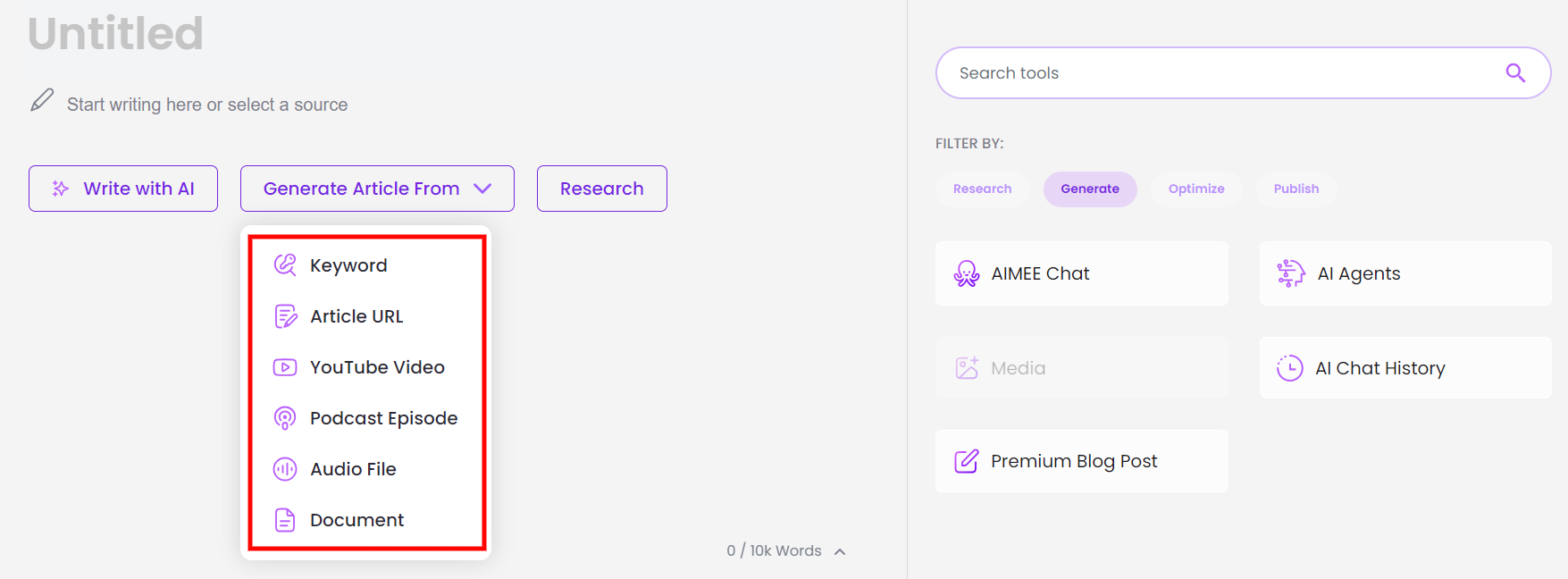
By publishing more blog content, you can reach a larger audience and drive greater engagement with potential customers. So why aren’t more businesses and publishers scaling their content creation?
The Challenges of Scaling Content Creation
Scaling content creation is no easy feat. It requires a lot of planning, coordination, and resources to produce quality content in an efficient manner. Here are some of the challenges associated with scaling content production:
Time Management
When creating multiple pieces of content at once, it can be difficult to manage your time effectively. You need to be able to prioritize tasks, plan ahead, and delegate responsibilities appropriately for everything to run smoothly.
This can be especially challenging if you are working with limited staff or you don’t have the resources they need. Having the right tools can significantly streamline your workflow and help you manage your time more effectively.
As we have discussed, there are tools for automating your content calendar, outlining your posts, writing content, and publishing to WordPress. There are also tools like:
- Ahrefs simplifies your keyword research.
- Slack for team collaboration.
- Grammarly for proofreading.
- Market Muse for optimizing your blog posts.
- Buffer for social listening and scheduling your new posts on social media.
These digital tools can save you a lot of time that you can then use for more strategic tasks.
Organizational Overhead
As your team grows, so does the amount of overhead required for organizing and managing your content creation projects. This includes tracking deadlines, assigning tasks, and monitoring progress across different teams and individuals involved in the process.
Without proper organization systems in place, it can quickly become overwhelming trying to keep up with all the moving parts involved with scaling content creation.
Adopting a project management approach with your content creation can help you stay organized as your team grows. Tools like Trello, Basecamp, Monday.com, Asana, and ClickUp can help you work in a more coordinated and organized way.
Quality Control
The more content your team has to produce at the same time, the harder it is to monitor for quality. The fact that there are more people involved in a project means there are more opportunities for mistakes or miscommunications.
To ensure that each task or piece of content doesn’t fall short of expected quality standards, it’s essential to assign enough resources for each piece of content.
Unless you are giving your writers tools for automating parts of the writing process, for example with an AI writer like BrandWell, avoid forcing your writers to work to tight deadlines. That only leads to the submission of thin, poorly-written articles.
To get maximum value out of scaling up blog post frequency without risking reader burnout, make sure each article offers something unique that provides real value for its intended audience.
Key Takeaway: Scaling content production requires a lot of foresight, organization, and resources to ensure success. It’s essential to budget wisely, optimize processes without compromising quality and follow SEO best practices to boost your chances for success.
Tips for Optimizing the Content Creation Process
Content optimization is essential for any successful content scaling strategy. It helps to ensure that your content reaches the right people, resonates with them, and drives conversions.
Here are some tips to guide your content scaling effort and ensure you get maximum value out of that content:
Research Relevant Keywords and Follow SEO Best Practices
Researching relevant keywords ensures that your content brings qualified traffic that is relevant to your business. Your goal when scaling content shouldn’t be to simply boost traffic to your blog. It should be to attract traffic that you can nurture into paying customers for your business.
An intentional keyword research process informs what format of blog post you need to create for each keyword and what other keywords a blog post can be optimized for. When done right, it also prevents you from creating content on keywords you have already targeted with existing content.
For example, you may feel after analyzing your Google Search Console data that you need to create a new post for a keyword one of your pages is appearing in Google for but which it wasn’t originally optimized for. But after careful analysis, you can also decide you are better off expanding the scope of the existing article with a new subheading targeting that keyword.
Stay Organized
Creating an editorial calendar can help you plan ahead, stay organized and ensure that no deadlines are missed during busy times. This way, you can easily keep track of deadlines and prioritize tasks accordingly so that nothing slips through the cracks during busy periods.
Create Engaging Titles
It’s important to give each post you publish the best chance of success on search engines and everywhere you promote it. That starts with your title. The SEO title should be attention-grabbing to entice clicks, but it must still accurately reflect what the article is about.
The best headlines include the target keyword, a number, a power word, and if possible an element of intrigue. It is good practice to draft a few headline variations (10 is a good number) and test them to see which one will perform best. Use a headline analyzer tool like CoSchedule to test your headlines for word balance, sentiment, clarity, and character count.
Write with Clarity and Brevity in Mind
Writing concisely ensures that your articles get to the point fast and lay out all your points clearly. It helps readers stay engaged with each sentence rather than getting lost in fluff, jargon, and extraneous details that do not add any critical information to the piece of content.
Write using simple, everyday words and in short sentences and short paragraphs that make it easier to follow your train of thought and understand your points. Using an outline also helps to organize your thoughts and arrange your points in a logical order.
Remember to edit your articles before you publish them. No matter how talented a writer you are, having another person review and edit your content before you publish it is a good practice.
Two perspectives are always better than just the author’s. It’s also easy to miss typos and grammatical errors when editing your own work, so rather than editing your own articles, it may be better to have another set of eyes review them.
Key Takeaway: To succeed with content scaling, you must focus on quality and quantity together. Plan ahead with an editorial calendar and research relevant keywords to maximize search engine visibility. To ensure maximum impact for your content, write clearly and concisely then have a second pair of eyes look it over before publishing.
Automate and Simplify Your Content Scaling Efforts with BrandWell
Automation is a powerful tool for content production that saves you time and money. With a platform like BrandWell, you can ramp up your content creation and publish more articles without sacrificing quality.
The long-form articles that BrandWell generates are optimized for SEO because the tool crawls the top of Google to find what it is ranking for your target keyword right now. The articles come out pre-formatted, complete with a table of contents and key takeaway boxes.

UNLOCK YOUR POTENTIAL
Long Headline that highlights Value Proposition of Lead Magnet
Grab a front row seat to our video masterclasses, interviews, case studies, tutorials, and guides.

